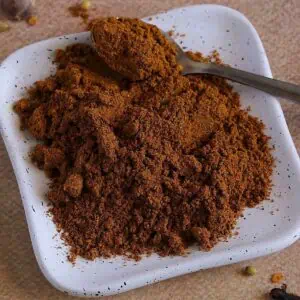Gujarati Methi Thepla, a must try lightly spices chapati like Indian flatbread is prepared from Whole Wheat flour, Fenugreek leaves, and other spices. Methi Thepla is light as well as healthy. It’s an all-time favorite at home.

It is typically served for breakfast and lunch with plain yogurt, Mango pickle or Aloo ki sabzi, Thepla recipe comes very handy as a lunch box recipe and also for on the go or while traveling.
I do make much variety of theplas like Zucchini thepla, carrot thepla, cabbage thepla, plain thepla.
Every household has their own recipe for making Thepla. Some make with multigrain flour, some add ginger-garlic paste, some makes it thick and some makes it thin. I learned this recipe from my Mom.
Thepla has a longer shelf life compared to any normal Indian flatbread and can be easily preserved for 3 to 4 days at room temperature. It also freezes so well for up to 2 to 3 months. I am sharing how to store it in the freezer for 2 to 3 months in the video down below. Also, I have mentioned tips to make soft and perfect thepla below.
This recipe will make 50 Methi Thepla(depending on the size).
Methi Thepla
Ingredients
- 3 cups Fresh Fenugreek leaves washed and chopped finely
- 4 cups Whole wheat flour
- Salt to taste
- 2 tablespoon Chili powder Or as per your spice level
- 1 teaspoon Turmeric powder
- 2 tablespoon Cumin-coriander powder
- ½ teaspoon Hing
- ¼ cup Oil + for frying the thepla
- 1 cup Curd
- 1 cup Water or as needed
Instructions
- Take whole wheat flour in a big mixing bowl. Add chili powder, turmeric powder, Cum-coriander powder, salt, hing, and oil. Mix them.
- Now add fenugreek/methi leaves and curd. Mix it with your fingertips well.
- Now add little water a time and knead into semi-soft dough. It should not be too hard or too soft.
- Cover it and keep it aside for 15 minutes.
- After 15 minutes, take some oil in hand and knead the dough once again to smooth out. Divide the dough into 50 equal balls, flatten it out between your palms and take it in the oiled bowl.
- With the help of dry flour, start rolling the thepla. Roll it into 6 to 7-inch diameter circle using a rolling pin. It should not be too thin or thick.
- Heat the tawa on a medium heat.
- Place rolled Methi thepla on hot tawa. Let it cook for 30 to 40 seconds or till you get few bubbles on the top.
- Flip it with help of a spatula. Drizzle some oil and spread evenly. Again flip it, press it lightly with a spatula and cook until bottom side is cooked. Apply some more oil on top and flip and cook again by pressing until cooked.
- 10. Once cooked on both the sides remove it to the plate or in the container. Repeat the same process for the rest Methi thepla.
Video
Notes
- Let the Methi Thepla cools down completely.
Nutrition
Pin It for Later –










Love methi thepla or anything with methi! Your’s looks so good, Dhwani 🙂
Thanks Freda!! 🙂
I keep making these often, all time favourite. Yours looks tasty.
Thanks Jayashree!! <3
These are my all time favourite, will try your recipe soon?
These are my favorite too. Thanks 🙂
The herb methi is one of my fav, yours version is so yummy !!!
Thanks dear. 🙂
I always prepare Kathiyawadi methi thepla, next time will try these plain ones, yummy!
Yeah Jagruti, I also do make Kathiyawadi THepla. But this one is our go-to recipe. Thanks for stopping by!! 🙂
Love methi in any form.. and these Theplas looks so soft and full of amazing flavors!! Loved the video too
Thanks Soniya. I love methi too! 🙂
Can I make this with white flour? I can’t do wheat. thanks
Yes Libby, You can use White flour. Thanks for stopping by!! 🙂
HiDhwani
Just stumbled upon your recipe
It looks delicious
Loved that it can stay fesh for so long
Just one query, if i want to take it along abroad
Will it remain okay while traveling? The traveling time would be two days
Il freeze it when I reach
Would that be ok?
Hi Esha!!
Thanks for stopping by. Yes, It will remain fresh for 2 to 3 days.
Same here..if i carry abroad..can we eat it upto 5-6 days…
Whether curds contaminate
Yes, Nikita! You can.
Thank you so much for such a nice way to explain recipe…. A specialy for frozen method of thepla it’s help me a lot…..
Amazing recipie of thepla to take it along abroad.Thank you so much.
Thank you, Anupa! 🙂
Thanks for sharing such a nice recipie.. just a small query. Do you mean deep freezing or normal fridging? I want to take it abroad and want to preserve it for 2 months. Should we keep in ice compartment?
Hi Sandhya!
Store this in deep freezer(not in the fridge). I hope this helps.
I made this last night. I have been unsuccessful in recreating this recipe by my mum who passed away just over a year ago. I came across your recipe and decided to try it. I followed your recipe and instructions plus watched the video. 3 changes I made was 1. Halved the ingredients 2. Added a little organic Jaggery 3. Blanched the Methi ( because uncooked Methi disturbs my tummy). I waited till the water was drained from the blanched Methi before starting with this dough recipe. This afternoon, I heated it up for lunch and for the First time….. it was still soft. I was absolutely overjoyed. Thank you so much for this recipe. As I don’t eat besan…this was a recipe just right for me. 🥰
So good to read your feedback dear. Thank you so much! <3
Want to carry thepla abroad for 25days.so any tip while making dough and in storing too.
How long will the theplas last if stored in fridge (not freezer)?
About a week.